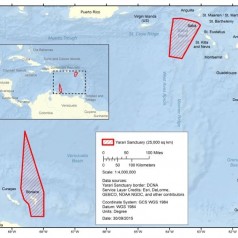
One of the goals of the Save Our Sharks project is the establishment of shark sanctuaries around the six Dutch Caribbean islands. The plight of conserving sharks is well known, argued from both an ecological, and socio-economic perspective. But science has only recently started to uncover to what extent local protection measures, such as the allocation of protected areas, can contribute to this.
A marine reserve is an allocated area where all human activity is excluded. Technically, the area is only a reserve if all fishery, and industrial development is fully excluded. However, depending on the objectives of the reserve, exclusions may slightly vary. A marine reserve and a marine protected area (MPA) are distinct policy measures in the sense that the latter still allows for certain fisheries, and other human activities, such as touristic exploitation, albeit under regulation. The purpose of marine reserves can either be the improvement of an entire ecosystem, as in the Great Barrier Reef reserve, or the protection of single animal groups, as with the recently announced Yarari reserve for sharks and marine mammals.
The ecological effects of marine reserves are very complex and specific to the area, but certain inferences can be made about the use of reserves as a species conservation measure. A soon to be published meta-analyis by Marissa Baskett and Lewis Barnett [1] demonstrates how marine reserves generally lead to older and larger animals living within its borders, larger population sizes, and the preservation of high biodiversity, and genetic diversity. However, the effect on particular species can be totally divergent. The increase of certain animals can subsequently lead to a decrease in others, because of increased predation, and competition for resources. Therefore, many scientists contend that the effect of local protection measures should not be assessed on a single species-basis, but on the ecosystem as a whole, as much as possible.
Different studies regarding the effects of local protection measures on shark populations demonstrated that excluding fisheries could have a positive effect on the local abundance of sharks [2]. This mainly applies to shark species with small home ranges, that spend a relatively large amount of time in the protected area, which decreases the chance of them being fished up outside of the reserve. Hence, the shark species that migrate long distances are more difficult to protect with local measures. For migratory species it is key to determine which areas they use to reproduce, or forage, and try to protect these areas.
In the Dutch Caribbean, the Caribbean reef shark, lemon shark, and nurse shark are examples of species that spend the majority of their time in small ranges. They even often give birth in the same locations in which they were born. Local protection measures of such places could thus highly contribute to survival of the species.
But with only few shark species actually staying within national borders, the connection between protected areas is imperative. Together, countries should work towards creating a network of protected areas, to provide maximum coverage of the habitat of their shark species. This means the Dutch Caribbean islands do not only need to cooperate amongst themselves, but also work closely with other countries around them.
-
Baskett, M.L. & Banett, L.A.K. (2015) The Ecological and Evolutionary Consequences of Marine Reserves. Annual Review of Ecology, Evolution, and Systematics. DOI: 10.1146/annurev-ecolsys-112414-054424
Knip, D.M., Heupel, M.R., Simpfendorfer, C.A. (2010) Evaluating marine protected areas for the conservation of tropical coastal sharks. Biological Conservation, 148: 200-209.
White, E.R., Myers, M.C., Flemming, J.M., Baum, J.K. (2015) Shifting elasmobranch community assemblage at Cocos Island—an isolated marine protected area. Conservation Biology, 29 (4): 1186-1197.
By Linda Planthof





